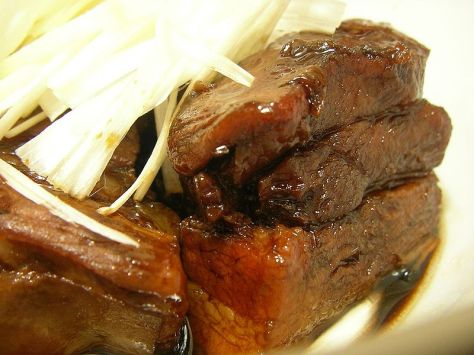
Kakuni (角煮) is a Japanese braised pork dish which literally means “square simmered”.
Kakuni is a meibutsu (名物/famous regional product) of Nagasaki.
Actually this is not a strictly traditional Japanese dish as its most likely Chinese, similar to Dongpo’s pork, though not as heavy in sauce.

Kakuni as served in some restaurants cut and cold
During the Ming Dynasty and Song Dynasty, the main Sino-Japanese trading route existed between Hangzhou and Kyūshū. Many Chinese lived in major Kyūshū port cities, such as Nagasaki and Japanese in Hangzhou. Therefore pork, was popularized in major Kyūshū cities.
These days kakuni is popular all over Japan with very many varieties depending on the region, climate and prevailing tastes.

Okinawa, probably the region in Japan consuming the largest quantity of pork in Japan has its own recipe called “Rafti”!
PREPARATION:
Kakuni is made of thick cubes of pork belly simmered in dashi, soy sauce, mirin, sugar and sake. By cooking it for a long time over a low temperature the collagen breaks-down into gelatin keeping the meat moist while becoming extremely tender allowing it to be consumed with chopsticks easily. The dish is often served with scallions, daikon and karashi.
Will publish a recipe soon!
——————————————
DONG PO ROU

For the record, as it is the origin of Kakuni, Dongpo’s pork is a famous Hangzhou dish which is made by pan-frying and then red cooking pork belly. The pork is cut to around 2 inches square in dimensions, consisting of half fat and half lean meat. The mouth feel is oily but not greasy, with the fragrance of wine.
ORIGINS:
Legend has it that while Su Dongpo was banished to Huangzhou, in a life of poverty, he made an improvement of the traditional process. He first braised the pork, added Chinese fermented wine and made red-braised pork, then slowly stewed it on a low heat. This dish was first launched in Huangzhou, then spread to Hangzhou, the capital of the Southern Song Dynasty, flourished, and then became one of Hangzhou’s most famous dishes.
Please check the new postings at:
sake, shochu and sushi
—————————————-
日本語のブログ
—————————————-
Man that looks good. I love the taste of that fatty porkish belly. Do you by any chance add chili to this dish? If so what would you recommend?
LikeLike
Dear Friend!
Greetings!
Of course you may add chili and star anise, too!
I’m going to run a series of recipes you can check!
Cheers,
Robert-Gilles
LikeLike
The only thing that’s missing is some rice. lol. Looks wonderful.
LikeLike
Dear Jenn!
Youa are right, although the Japanese tend to eat this as a snack!
Cheers,
Robert-Gilles
LikeLike
The weather is beginning to get cool and this looks like just the thing… my mouth is watering!
LikeLike
Dear Frank!
Greetings!
I wished the weather cooled down here!
LOL
Cheers,
robert-Gilles
LikeLike
Dear Robert,
This is indeed one delicious pork dish. Thanks for the write out on it…very enriching..:)))
LikeLike
Dear Elin!
You are most welcome!
Cheers,
Robert-Gilles
LikeLike
I seriously didn’t know that there’s such a dish in Japan! But it certainly looks very oiishi!!! Actually, curiously how did you get so good in your nihongo?
LikeLike
Dear Friend!
Greetings again!
You can find almost any food in Japan!
As for nihongo, I’ve live in Japan for 33 years!
Cheers,
Robert-Gilles
LikeLike